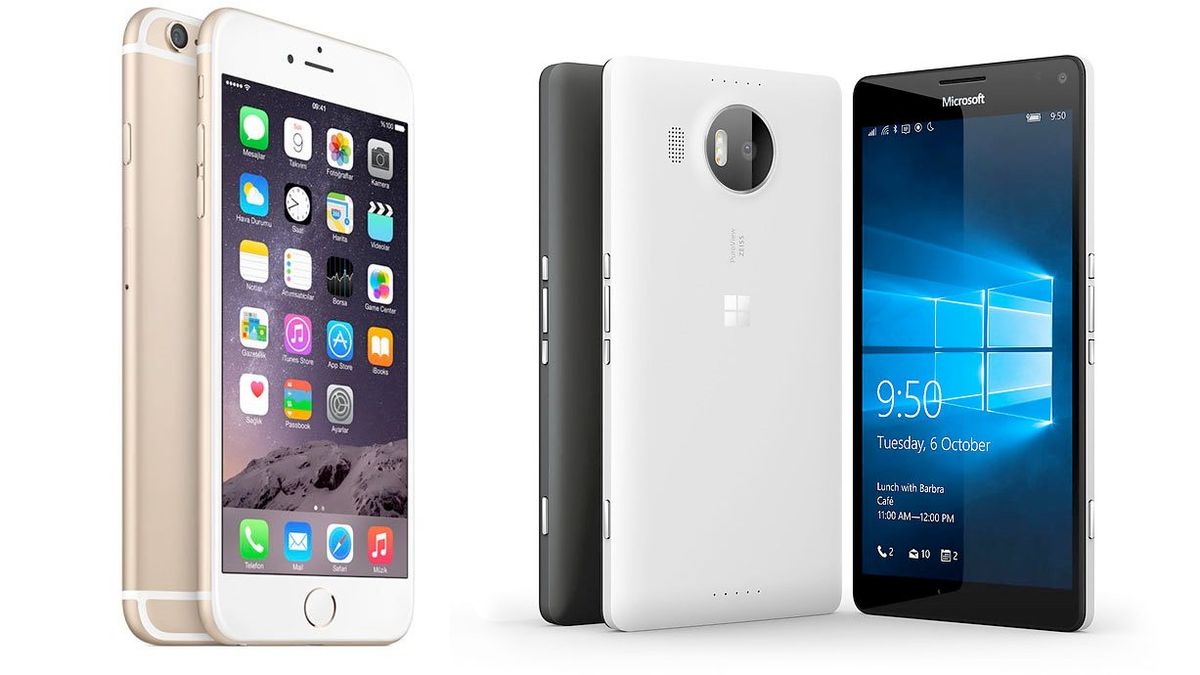Big phone showdown: Lumia 950 XL versus iPhone 6s Plus

It's been a while since the last huge Windows flagship phone, but Microsoft is back in a big fashion with the Lumia 950 XL. It's the first truly big Windows phone since the Nokia Lumia 1520 of two years ago. In the time since, the competition's also gone huge, including Apple with their iPhone 6s Plus. So how do these two giant phones compare? That's what we're here to find out.
| Category | Lumia 950 XL | iPhone 6s Plus |
|---|---|---|
| OS | Windows 10 Mobile | iOS 9 |
| Screen Size | 5.7 inches | 5.5 inches |
| Screen Resolution | 1440x2560 (564ppi) | 1080x1920 (401ppi) |
| Screen Type | OLED | IPS LCD |
| Processor | Snapdragon 810 64-bit octa-core | Apple A9 64-bit dual-core |
| RAM | 3GB | 2GB |
| Internal Storage | 32GB | 16GB/64GB/128GB |
| External Storage | microSD | — |
| Security | Windows Hello iris scanner | Touch ID fingerprint scanner |
| Rear Camera | 20MP ƒ/1.9 PureView camera, triple-LED flash | 12MP ƒ/2.2 iSight camera, dual-LED flash |
| Front Camera | 5MP, wide-angle lens | 5MP, screen flash |
| Battery | 3340mAh removable | 2750mAh non-removable |
| Charging | Qi wireless, USB Type-C port, Quick Charge | Lightning port |
| Height | 151.9mm | 158.2mm |
| Width | 78.4mm | 77.9mm |
| Thickness | 8.3mm | 7.2mm |
| Weight | 165g | 192g |
As with the Lumia 950 vs. iPhone 6s comparison, the Lumia 950 XL and iPhone 6s Plus are seriously different phones (iMore's review of the iPhone 6s Plus tells you just as much), with Apple's flagship seemingly lagging behind on the battery, camera, screen resolution, and more. But Apple has a knack for making less do more and few iPhone 6s Plus owners are complaining about the quality of the display or the longevity of that battery. It's a closer comparison with the two big phones than it is between the smaller ones, that's for sure.
Still, there are areas where the Lumia 950 XL stands out even on paper. The rear camera will take significantly larger photos, for sure, and Lumia phones have always rivaled the iPhone for the quality of their photos. And with USB Type-C, Qi wireless charging, and Qualcomm Quick Charge all built in, you've got more and faster options for getting that large battery pack topped off. And the screen, oh the screen — a larger screen with 75% more pixels in a body roughly the same size.
And that's not even mentioning the software differences here. Windows 10 Mobile and iOS 9 have never been more alike and more different at the same time. It's an odd dichotomy — Live Tiles and home screen icon grids couldn't be more different, yet they both have a rather traditional notification drawer and in-app navigation schemes. But those difference go further than skin-deep — Windows 10's coming to the table with things that iOS doesn't even dream of offering, like Continuum docking support where your phone essentially turns into a miniature desktop computer, complete with monitor and external input support.
All of that, however, only matters if you buy the phone, and that's historically been the weak point in Microsoft's strategy — Windows 10 Mobile is powerful and elegant and robust, but they just can't seem to convince customers to actually buy devices that run it. Overcoming that customer sentiment deficit is a tall order, but if there's any company with the expertise and resources to do it, it's Microsoft.
For the rest of our NYC #Windows10Devices coverage head here:
- Lumia 950
- Lumia 950 XL
- Surface Pro 4
- Surface XL
- Microsoft Band 2
Get the Windows Central Newsletter
All the latest news, reviews, and guides for Windows and Xbox diehards.
Derek Kessler is Special Projects Manager for Mobile Nations. He's been writing about tech since 2009, has far more phones than is considered humane, still carries a torch for Palm, and got a Tesla because it was the biggest gadget he could find. You can follow him on Twitter at @derekakessler.
